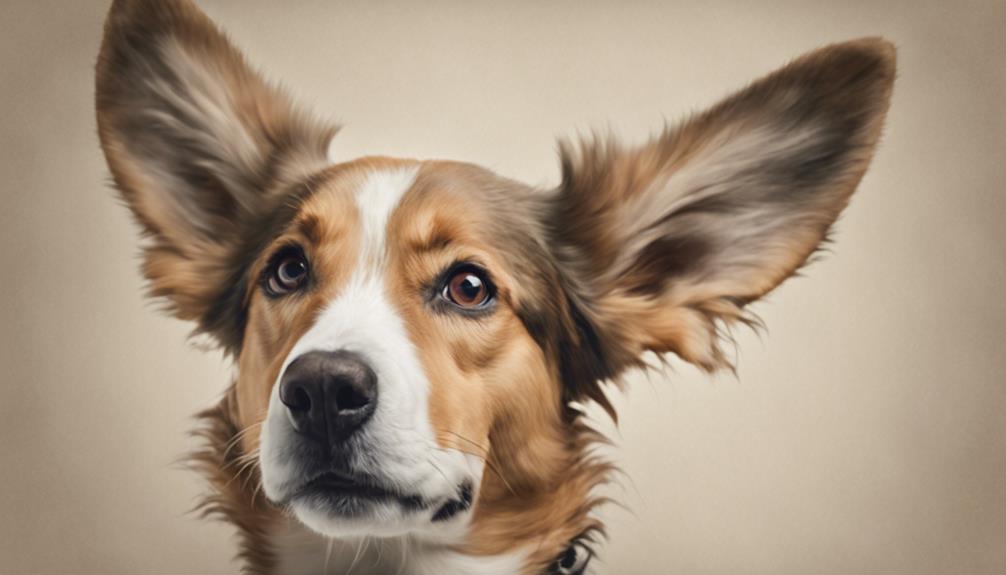What Does Your Dog's Behavior Really Mean?
Have you ever wondered why your dog behaves the way they do? Understanding your canine companion's behavior is crucial for building a strong bond and ensuring their well-being.
From tail wagging to vocalizations, each action conveys a message that goes beyond simple gestures. By deciphering the subtle cues and signals that your dog displays, you can gain valuable insights into their emotions and needs.
So next time your furry friend exhibits a particular behavior, it might be more than just a random act – it could be their way of communicating with you.
Understanding Dog Body Language
Do you know how to interpret your dog's body language accurately? Understanding your furry friend's behavioral cues is crucial for effective communication. Dogs primarily rely on body language for Canine communication, making it essential for pet owners to decipher these signals correctly.
When your dog is feeling happy and relaxed, you may notice a wagging tail, bright eyes, and a relaxed body posture. On the other hand, if your dog is feeling anxious or fearful, they might exhibit behaviors like yawning, lip licking, or avoiding eye contact. These subtle behavioral cues can provide valuable insights into your dog's emotional state.
Additionally, pay attention to your dog's ears, mouth, and overall body tension. Ears held back could indicate fear or submission, while a tense body and closed mouth might signal discomfort or aggression. By understanding these nuances in your dog's body language, you can strengthen your bond and create a harmonious relationship based on clear communication.
Decoding Tail Wagging
Wondering what your dog's tail wagging really means? Your furry friend's tail language can convey a variety of emotional cues. The speed at which your dog wags its tail can provide important communication signals. For example, a fast wagging tail often indicates excitement or happiness, while a slow wag may suggest uncertainty or caution. Paying attention to the context in which the tail wagging occurs is crucial for interpreting its meaning accurately.
When your dog greets you enthusiastically at the door with a high-speed wag, it's likely showing its delight at seeing you. On the other hand, if your dog encounters a new situation and hesitantly wags its tail slowly, it might be feeling unsure or apprehensive. Understanding these subtle cues can help you respond appropriately to your dog's needs and emotions. By observing your dog's tail wagging along with other body language signals, you can deepen your bond and strengthen the communication between you and your loyal companion.
Interpreting Ear Movements
When observing your dog's behavior, pay close attention to the movements of its ears as they can provide valuable insights into its current state of mind. Ear flicking and head tilting are behaviors that can indicate curiosity or alertness. If your dog is flicking its ears or tilting its head, it might be trying to understand a new sound or object in its environment.
On the other hand, ear flopping and ear perking can convey different emotions. Floppy ears often suggest relaxation or contentment, while perked ears indicate attentiveness or potential aggression. Understanding these ear movements can help you better interpret your dog's feelings and reactions in various situations.
Significance of Eye Contact
To understand your dog's emotional state better, pay attention to the significance of eye contact. Eye contact plays a crucial role in building trust and establishing communication cues with your furry companion. When your dog maintains eye contact with you, it can indicate a sense of connection and understanding. It's a way for them to express their emotions and communicate their needs non-verbally.
In dog behavior, prolonged eye contact can be a sign of trust building. By looking into your eyes, your dog is showing vulnerability and seeking reassurance from you. On the other hand, a lack of eye contact may suggest discomfort or unease. Understanding these subtle signals can help strengthen your bond and improve your communication with your dog.
Next time you interact with your dog, observe their eye contact and see if you can decipher their emotions and intentions. Remember, eye contact is a powerful tool in understanding your dog's behavior and fostering a deeper connection with them.
The Meaning Behind Barking
Pay attention to your dog's barking as it serves as a key form of communication revealing their emotions and needs. Dogs communicate through barking, and understanding the nuances can help you decipher what they're trying to tell you. Here are some key points to consider:
- Different Types of Barks: Pay attention to the pitch, duration, and intensity of the barks. A sharp, short bark may indicate alertness or a warning, while a continuous, high-pitched bark could signal distress or excitement.
- Growling Communication: Growling is a form of communication that can signify aggression, fear, or discomfort. It's essential to evaluate the situation and your dog's body language when they growl.
- Whining Emotions: Dogs often whine when they're seeking attention, feeling anxious, or in pain. Understanding the context of the whining can help address their needs promptly.
- Repetitive Barking: If your dog engages in persistent barking, it may indicate boredom, loneliness, or a need for exercise. Providing mental and physical stimulation can help curb this behavior.
- Environmental Triggers: Dogs may bark in response to various environmental stimuli such as other animals, noises, or strangers. Identifying these triggers can help you address the underlying cause of their barking.
Analyzing Paw Gestures
Understanding your dog's paw gestures can provide valuable insights into their feelings and intentions. When your furry friend engages in paw tapping, they're often trying to communicate with you. Paw tapping can be a way for your dog to seek attention, express excitement, or even indicate a desire to play. Pay attention to the context in which the paw tapping occurs to better understand what your dog is trying to convey.
On the other hand, if you notice your dog engaging in paw licking, it may be a sign of anxiety. Dogs may lick their paws excessively when they're feeling stressed, uncomfortable, or anxious. It's essential to observe your dog's overall body language and behavior to determine if paw licking is a response to anxiety. Providing a calm and reassuring environment for your pup can help alleviate their anxiety and reduce the need for paw licking.
Unveiling Vocalizations

When your dog vocalizes, they're expressing their emotions and needs through sounds that can provide valuable insights into their state of mind. Understanding these vocalizations can help you better comprehend what your furry friend is trying to communicate.
- Growling Communication: Growling is a form of communication for dogs. It can indicate feelings of fear, aggression, or discomfort. Pay attention to the context in which your dog is growling to decipher what they might be trying to convey.
- Whining Emotions: Dogs often whine when they're seeking attention, feeling anxious, or in pain. It's essential to assess the situation to determine the underlying cause of your dog's whining.
- Pitch and Tone: The pitch and tone of your dog's vocalizations can provide clues about their emotional state. High-pitched sounds may indicate excitement or distress, while low tones can signal relaxation or warning.
- Duration of Sounds: The duration of your dog's vocalizations can also offer insights. Prolonged barking might suggest boredom or a need for exercise, while short, sharp barks could signal alertness or playfulness.
- Body Language: Pay attention to your dog's body language when they vocalize. Combining vocal cues with visual cues such as tail wagging, ear position, and overall posture can give you a comprehensive understanding of your dog's feelings.
Grasping Social Signals
Grasping social signals from your dog involves keen observation and interpretation of their interactions with other animals and humans. When your dog engages in play behavior, such as bowing, wagging their tail, and making playful barks, it's a sign of a positive and friendly interaction. These cues show that your dog is comfortable and enjoying the social exchange.
On the other hand, recognizing fear signals is crucial for understanding when your dog is feeling anxious or threatened. Signs like cowering, tucked tail, ears pinned back, or growling can indicate that your dog is scared or uncomfortable in a particular situation. By paying attention to these fear signals, you can intervene to help your dog feel safe and secure.
Frequently Asked Questions
How Can I Tell if My Dog Is Feeling Anxious or Stressed?
You can tell if your dog is feeling anxious or stressed by observing signs like excessive panting, pacing, or drooling.
To help with separation anxiety, try gradually increasing alone time and using calming techniques like leaving a favorite toy or treat.
For canine phobias, behavior modification techniques such as desensitization and counterconditioning can be effective in helping your dog overcome fears and reduce stress levels.
Why Does My Dog Sometimes Growl or Show Aggression Towards Other Dogs or People?
When your dog growls or shows aggression towards others, it may be due to fear, resource guarding, or feeling threatened. Canine body language can provide clues to their state of mind. Proper socialization techniques from an early age can help prevent such behavior.
Always consult with a professional trainer or behaviorist to address and correct aggressive tendencies in your dog. Consistent training and positive reinforcement are key in managing and modifying this behavior.
What Does It Mean When My Dog Licks Me Excessively?
When your dog licks you excessively, it's often a way of showing affection and seeking attention. This behavior is a form of bonding and communication.
Dogs use licking as a way to express their feelings towards you and to strengthen the connection between the two of you.
How Can I Tell if My Dog Is in Pain or Discomfort?
You can tell if your dog is in pain or discomfort by observing their body language and vocal cues. Signs like whimpering, excessive panting, or reluctance to move could indicate they're hurting.
Also, if your dog suddenly becomes clingy and seeks more attention than usual, it might be a way of communicating their need for comfort.
Paying attention to these signals can help you address any potential issues promptly.
Why Does My Dog Sometimes Exhibit Destructive Behavior, Such as Chewing on Furniture or Shoes?
When your dog sometimes chews on furniture or shoes, it could be due to separation anxiety, boredom, teething, or lack of exercise.
Dogs may act out destructively when feeling anxious or understimulated. Providing mental and physical exercise, interactive toys, and creating a safe and secure environment can help curb these behaviors.
Understanding why your dog is exhibiting these actions can guide you in finding solutions to address their needs and prevent destructive behavior.
Conclusion
Now that you know how to decode your dog's behavior, you can better understand what they're trying to communicate with you. Pay attention to their body language, tail wagging, ear movements, eye contact, barking, paw gestures, vocalizations, and social signals.
By being more observant and aware of these cues, you can strengthen the bond with your furry friend and ensure a happier and healthier relationship with them.
